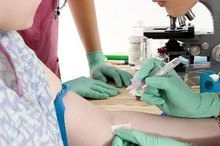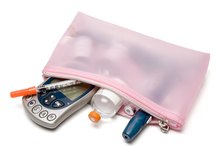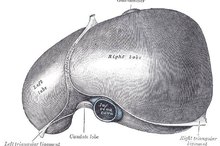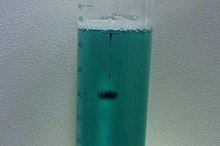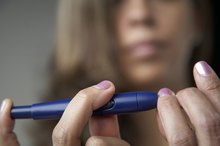Reasons for Elevated A1c Without Diabetes
An A1c blood test, also called hemoglobin A1c, is recommended by the American Diabetes Association (ADA) for prediabetes and diabetes screening, and recommended for routine monitoring of blood sugar levels in people with diabetes 3. A1c is a form of hemoglobin -- a protein in red blood cells -- that has combined with a molecule of blood sugar or glucose. As a marker for how much glucose has been present in the blood over time, elevated A1c values are most commonly seen in people with prediabetes and diabetes 3. However, in certain medical situations, A1c may be elevated in someone who does not have these conditions.
Blood Glucose History
A1c forms naturally when glucose is present in the blood. The percentage of A1c increases in proportion to the average blood glucose level over the previous 2 to 3 months -- a reflection of the average lifespan of red blood cells. An A1c test of 5.6 percent or below is reflective of normal blood sugar levels -- or a daily average below 115. According to the 2016 ADA clinical practice recommendations, the A1c test may be used to reliably diagnose prediabetes and diabetes. According to these guidelines, an A1c of 5.7 to 6.4 percent is used to diagnosed prediabetes, and an A1c of 6.5 percent can be used to confirm the diagnosis of diabetes.
- A1c forms naturally when glucose is present in the blood.
- The percentage of A1c increases in proportion to the average blood glucose level over the previous 2 to 3 months -- a reflection of the average lifespan of red blood cells.
Anemia
What Is High RDW and Low Ferritin?
Learn More
An A1c value represents the percent of the total hemoglobin in the A1c form. Both an increase of A1c hemoglobin -- due to the presence of high blood sugar -- or a decrease in total hemoglobin can make the A1c percentage higher. Certain types of anemia associated with decreased hemoglobin production or longer lifespan of red blood cells can elevate the proportion of hemoglobin present in the A1c form. People with anemia due to lack of iron, folate or vitamin B12 may have an elevated A1c without having diabetes. Even the anemia common in the last trimester of pregnancy can falsely elevate A1c levels. Anemia caused by certain types of kidney disease may also cause an increased A1c level.
- An A1c value represents the percent of the total hemoglobin in the A1c form.
- Certain types of anemia associated with decreased hemoglobin production or longer lifespan of red blood cells can elevate the proportion of hemoglobin present in the A1c form.
Genetic Conditions
People with genetic conditions that affect the composition of their hemoglobin proteins may have high A1c values without diabetes 3. Examples of genetic conditions that may cause a falsely elevated A1c value include sickle cell trait and S-beta-thalassemia. However, several genetic blood disorders that cause premature red blood cell breakdown commonly cause low A1c values. If you carry the sickle cell trait or another one of these genetic hemoglobin disorders, your doctor may be able to use a different A1c assay or type of blood test to accurately measure your average blood sugar level.
- People with genetic conditions that affect the composition of their hemoglobin proteins may have high A1c values without diabetes 3.
- Examples of genetic conditions that may cause a falsely elevated A1c value include sickle cell trait and S-beta-thalassemia.
Medications
What Are the Normal A1c Levels for Children?
Learn More
Certain medications may also cause elevated A1c test results. Examples of drugs that increase blood glucose levels, even in people without diabetes, include corticosteroids, such as:
- prednisone,
- the antiseizure medication phenytoin (Dilantin)
Some antiviral medications used to treat human immunodeficiency virus can also elevate blood glucose, including fosamprenavir (Lexiva) and saquinavir (Invirase). Drugs used after organ transplantation may suppress hemoglobin production and cause an increase in A1c levels. If the A1c test accurately relfects elevations in blood glucose levels, treatment may be needed to correct this drug side effect. If high blood sugar levels persist or if you need to be on this drug long-term, your doctor may refer to your condition as drug-induced diabetes.
- Certain medications may also cause elevated A1c test results.
- If the A1c test accurately relfects elevations in blood glucose levels, treatment may be needed to correct this drug side effect.
There are a variety of reasons that an A1c level may be increased in someone without diabetes. While efforts to standardize A1c tests have been in place since 1996, inaccuracies in measurement and suboptimal standardization still persists, according to a report in the May 2011 issue of "Diabetes Care." Certain chemicals in the blood formed naturally or from the use of medicines may also interfere with the test 3. Since the A1c test is a reflection of average blood glucose control, your doctor can order other blood tests if a falsely high level is suspected. If you are concerned about the accuracy of your A1c test result, talk to your doctor.
- There are a variety of reasons that an A1c level may be increased in someone without diabetes.
- Since the A1c test is a reflection of average blood glucose control, your doctor can order other blood tests if a falsely high level is suspected.
Related Articles
References
- Diabetes Care: International Expert Committee Report on the Role of the A1C Assay in the Diagnosis of Diabetes
- International Journal of Diabetes in Developing Countries: Hemoglobin Variants Detected by Hemoglobin A1c (HbA1c) Analysis and the Effects on HbA1c Measurements
- Diabetes Care: The Pros and Cons of Diagnosing Diabetes With A1C
- Clinica Chimica Acta: Falsely Elevated Hemoglobin A1c Due to S-Beta+-Thalassemia Interference in Bio-Rad Variant II Turbo HbA1c Assay
- Diabetes Care: Standards of Medical Care in Diabetes -- 2016
- National Glycohemoglobin Standardization Program: Factors That Interfere With HbA1c Test Results
- Journal of the American Society of Nephrology: Diagnostic Application of the A1c Assay in Renal Disease
- American Association for Clinical Chemistry. Hemoglobin A1c. Lab Tests Online. Updated January 31, 2020.
- American Diabetes Association. Classification and Diagnosis of Diabetes: Standards of Medical Care in Diabetes—2018. Diabetes Care. January 2018;41(Suppl. 1):S13–S27. doi:10.2337/dc18-S002
- American Diabetes Association. 2. Classification and diagnosis of diabetes: Standards of Medical Care in Diabetes-2020. Diabetes Care. 2020;43(Suppl 1):S14-S31. doi:10.2337/dc20-S002
- National Institute of Diabetes and Digestive and Kidney Diseases. The A1C Test & Diabetes. Published April 2018.
- American Diabetes Association. Diabetes Symptoms.
- Garber AJ, Abrahamson MJ, Barzilay JI, et al. Consensus Statement by the American Association of Clinical Endocrinologists and American College of Endocrinology on the Comprehensive Type 2 Diabetes Management Algorithm—2018 Executive Summary. Endocrine Practice. January 2018;24(1):91-120. doi:10.4158/CS-2017-0153
- American Diabetes Association. 6. Glycemic Targets: Standards of Medical Care in Diabetes-2020. Diabetes Care. 2020;43(Suppl 1):S66-S76. doi:10.2337/dc20-S006
- National Institute of Diabetes and Digestive and Kidney Diseases. Diabetes Blood Tests for People of African, Mediterranean, or Southeast Asian Descent. Published October 2011.
- American Diabetes Association. Diagnosis.
- American Diabetes Association. 6. Glycemic targets: Standards of Medical Care in Diabetes—2019. Diabetes Care 2019;42(Suppl. 1):S61–S70. doi:10.2337/dc19-S006
Writer Bio
Dr. Margaret Baker studied biochemistry, pharmacology and nutrition, and conducted research on cancer therapeutics. She served as a patent agent for the biopharmaceutical division of a Fortune 500 company. Dr. Baker has published in peer reviewed journals, e-Books, and is a frequent commenter on discoveries in the life sciences.


